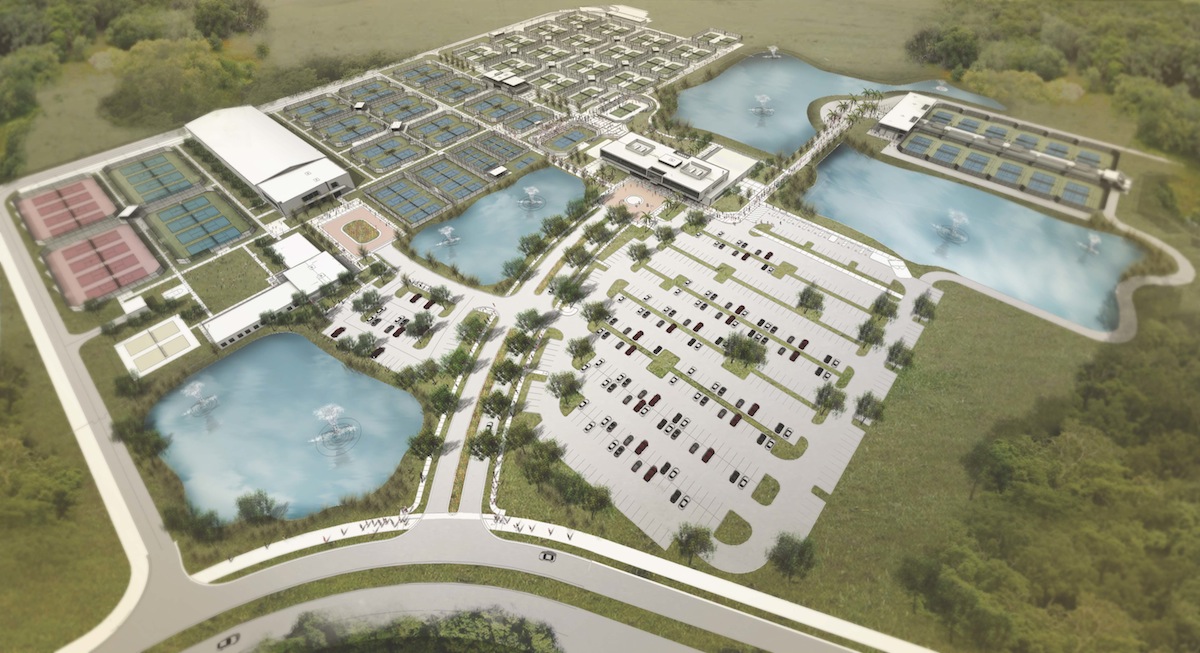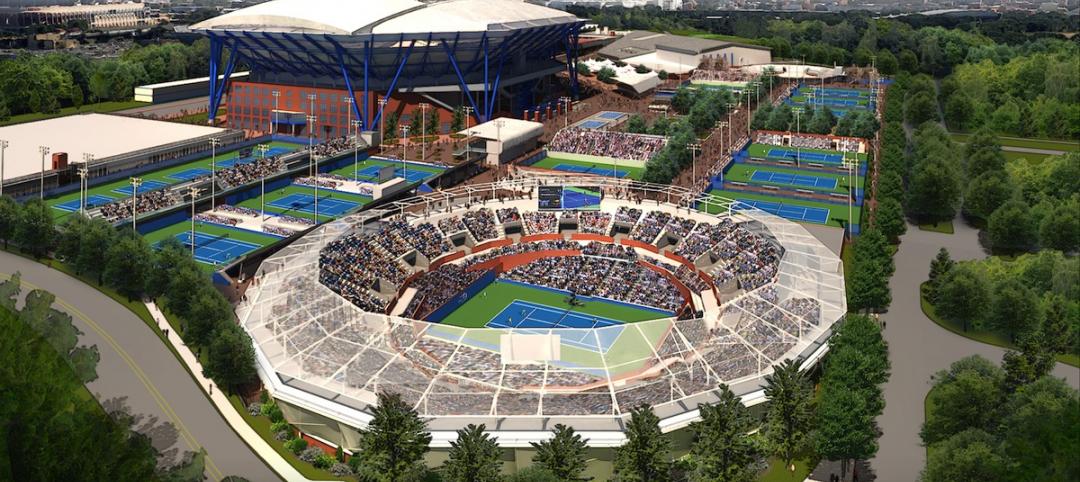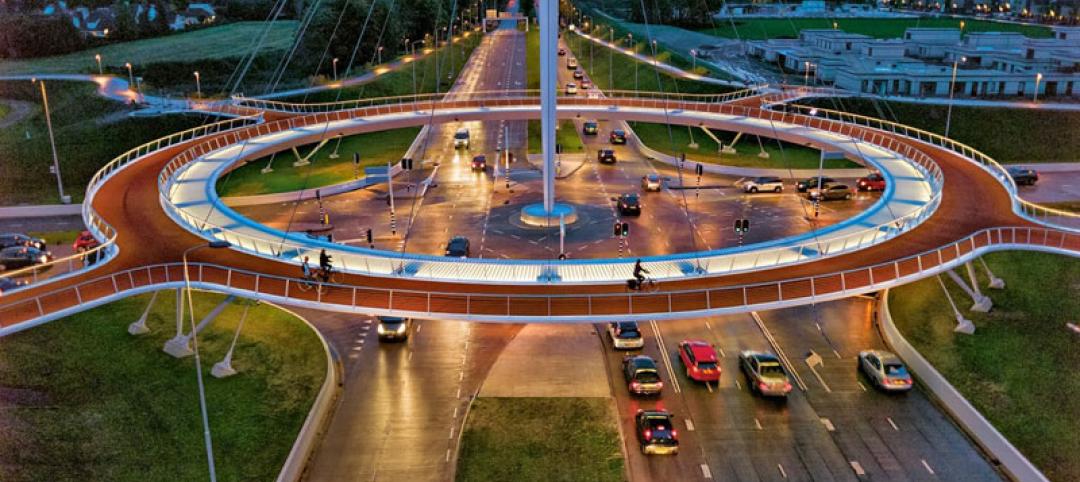On April 8, the United States Tennis Association broke ground on its $60 million USTA National Campus in Lake Nona, near Orlando, one of the country’s fastest-growing communities. With 106 courts and 270,000 sf, USTA’s New Home of American Tennis, as it is being called, will be the largest tennis complex in the U.S.
When completed in late 2016, this 63-acre facility—USTA’s first year-round outdoor construction project—will include a Tournament and League Area with 32 Har-Tru clay courts, and 20 Plexicushion hard courts; a Collegiate Tennis Area with 12 Plexicushion hard courts and one future tournament show court; and a Team Tennis USA Area with 12 hard courts that will be used by the 17 USTA Sections, along with local coaches and their players throughout the country to work collaboratively with USTA Player Development.
A High Performance and Player Development Area—with eight Duro-turf hard courts and eight red clay courts—will be able to house 32 boys and girls, and include strength and conditioning components. The complex will also feature indoor and family-area courts, a pro shop, fitness center, locker rooms, lounges, a café-restaurant, and USTA offices.
The USTA National Campus will be a cornerstone for the community’s Sports Innovation & Performance District, an emerging athletic district with a focus on research, design, innovation and technology.
An on-site stadium will be able to accommodate two matches simultaneously and seat 1,200 spectators.
The Building Team on this project consists of Tavistock Development (developer), HKS Architects (architect), BBM (structural engineer), Exp (MEP engineer), EDSA (landscape architect), and DPR Construction (GC). California Products, Har-Tru, and Connor SportCourt are supplying the court surfaces.
“By housing our two divisions devoted to growing the game at all levels, and training the next generation of players and coaches, we can have a greater impact on the sport than we ever had before,” says Katrina Adams, USTA’s chairman and president. (This complex would replace the association’s smaller training facility in Boca Raton, Fla.) Among the dignitaries at the groundbreaking were City of Orlando Mayor Buddy Dyer, and Orlando County Mayor Teresa Jacobs.
The 11-square-mile Lake Nona was a golf community surrounded by farmland and pastures when Tavistock Group, the developer’s parent, acquired it in 1996. The community is part of Orlando, and Tavistock has been working with that city’s economic development team to transform Lake Nona into what local officials are touting as city of tomorrow.
The USTA National Campus will be a cornerstone for the community’s Sports Innovation & Performance District, an emerging athletic district with a focus on research, design, innovation and technology. “We are launching what we think is the perfect partner to our Medical City,” said Rasesh Thakkar, senior managing director of Tavistock Group.
Over the past decade, Lake Nona has seen more than $2.8 billion and 2.4 million sf of clinical, institutional, laboratory space, and infrastructure completed or in active construction. The 650-acre Lake Nona Medical City health and science park—whose institutions include the University of Central Florida Health Sciences Campus and Sanford-Burnham Medical Research Institute—this year is adding the Orlando Veterans Affairs Medical Center and GuideWell Innovation Center.
Lake Nona’s 7,000 entitled acres offer nine residential communities that currently house about residents. Rob Adams, a vice president with Tavistock Development, tells BD+C that the community is entitled to build between 9,000 and 11,000 dwelling units, and will eventually house between 25,000 and 30,000 people.
The community is already served by three public schools, and three colleges. More than 5 million sf of commercial and retail spaces are in place. Lake Nona is where Johnson & Johnson has been conducting its multimillion-dollar, multiyear study on health and wellness. And the community is planning a 334-acre city park that will be Orlando’s largest.
Adams says Lake Nona’s build out is expected to take between 10 and 15 years. And he anticipates that the tennis complex will be a magnet for other business, such as apparel and fitness retailers, to come to this community.
Related Stories
| Apr 2, 2014
8 tips for avoiding thermal bridges in window applications
Aligning thermal breaks and applying air barriers are among the top design and installation tricks recommended by building enclosure experts.
| Mar 26, 2014
Callison launches sustainable design tool with 84 proven strategies
Hybrid ventilation, nighttime cooling, and fuel cell technology are among the dozens of sustainable design techniques profiled by Callison on its new website, Matrix.Callison.com.
| Mar 25, 2014
Sydney breaks ground on its version of the High Line elevated park [slideshow]
The 500-meter-long park will feature bike paths, study pods, and outdoor workspaces.
| Mar 20, 2014
Common EIFS failures, and how to prevent them
Poor workmanship, impact damage, building movement, and incompatible or unsound substrate are among the major culprits of EIFS problems.
| Mar 13, 2014
Do you really 'always turn right'?
The first visitor center we designed was the Ernest F. Coe Visitor Center for the Everglades National Park in 1993. I remember it well for a variety of reasons, not the least of which was the ongoing dialogue we had with our retail consultant. He insisted that the gift shop be located on the right as one exited the visitor center because people “always turn right.”
| Mar 12, 2014
14 new ideas for doors and door hardware
From a high-tech classroom lockdown system to an impact-resistant wide-stile door line, BD+C editors present a collection of door and door hardware innovations.
| Feb 26, 2014
Billie Jean King National Tennis Center serving up three-phase expansion
The project includes the construction of two new stadiums and a retractable roof over the existing Arthur Ashe Stadium.
| Feb 14, 2014
First look: Kentucky's Rupp Arena to get re-clad as part of $310M makeover
Rupp Arena will get a 40-foot high glass façade and a new concourse, but will retain many of its iconic design elements.
| Feb 14, 2014
Crowdsourced Placemaking: How people will help shape architecture
The rise of mobile devices and social media, coupled with the use of advanced survey tools and interactive mapping apps, has created a powerful conduit through which Building Teams can capture real-time data on the public. For the first time, the masses can have a real say in how the built environment around them is formed—that is, if Building Teams are willing to listen.
| Feb 11, 2014
World's first suspended bicycle roundabout [slideshow]
Located in the Netherlands, the project was designed to promote a healthier lifestyle.

















